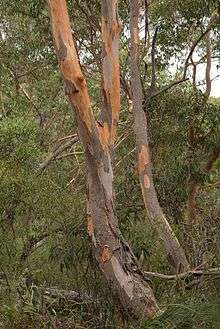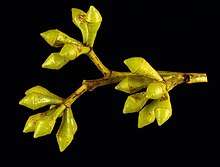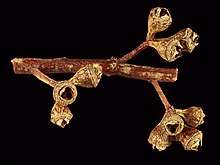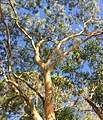Eucalyptus punctata
Eucalyptus punctata, commonly known as grey gum,[2] is a small to medium-sized tree that is endemic to eastern Australia. It has smooth grey bark that is shed in patches, lance-shaped, curved or egg-shaped adult leaves flower buds in groups of seven, white flowers and hemispherical or cup-shaped fruit. Its leaves are one of the favoured foods of the koala.
| Grey gum | |
|---|---|
 | |
| Eucalyptus punctata in Heathcote National Park | |
| Scientific classification | |
| Kingdom: | Plantae |
| Clade: | Tracheophytes |
| Clade: | Angiosperms |
| Clade: | Eudicots |
| Clade: | Rosids |
| Order: | Myrtales |
| Family: | Myrtaceae |
| Genus: | Eucalyptus |
| Species: | E. punctata |
| Binomial name | |
| Eucalyptus punctata | |
| Synonyms[1] | |
| |


Description
Eucalyptus punctata is a tree that typically grows to a height of 35 m (115 ft) and forms a lignotuber. It has smooth grey, brown or cream-coloured bark that is shed in patches. Young plants and coppice regrowth have dull green leaves that are paler on the lower surface, egg-shaped to lance-shaped, 55–115 mm (2.2–4.5 in) long and 15–35 mm (0.59–1.38 in) wide and petiolate. Adult leaves are glossy dark green, paler on the lower surface, lance-shaped or curved to egg-shaped, 60–180 mm (2.4–7.1 in) long and 14–37 mm (0.55–1.46 in) wide tapering to a petiole 13–26 mm (0.51–1.02 in) long. The flower buds are arranged in leaf axils in groups of seven on an unbranched peduncle 10–20 mm (0.39–0.79 in) long, the individual buds on pedicels 2–8 mm (0.079–0.315 in) long. Mature buds are oval, 6–9 mm (0.24–0.35 in) long and 4–9 mm (0.16–0.35 in) wide with a conical to rounded operculum. Flowering occurs from December to March and the flowers are white. The fruit is a woody, cup-shaped or hemispherical capsule 4–9 mm (0.16–0.35 in) long and 6–10 mm (0.24–0.39 in) wide.[2][3][4][5]
Taxonomy
Eucalyptus punctata was first formally described in 1828 by Swiss naturalist Augustin Pyramus de Candolle in his book Prodromus Systematis Naturalis Regni Vegetabilis.[6][7] The specifici epithet (punctata) is from the Latin adjective punctatus meaning "spotted" and refers to the oil glands, which give the leaves a dotted appearance.[8]
It is one a group of related species known collectively as large-fruited grey gums found in eastern Australia, the others being E. longirostrata from eastern Queensland, E. biturbinata from the New England region, and E. canaliculata from the vicinity of Gloucester and Dungog in central-northern New South Wales.[8][4]
Distribution and habitat
Grey gum occurs through the ranges and near coastal areas from near Gympie in Queensland to near Nowra in New South Wales, most commonly on transition zone soil types between sandstone and shale.[8]
It grows in tall open sclerophyll forest, associated with such species as red bloodwood (Corymbia gummifera), pink bloodwood (C. intermedia), spotted gum (C. maculata), white stringybark (E. globoidea), Sydney peppermint (E. piperita), blackbutt (E. pilularis), yellow box (E. melliodora), mountain grey gum (E. cypellocarpa), narrow-leaved ironbark (E. crebra), grey ironbark (E. paniculata), broad-leaved white mahogany (E. umbra), white mahogany (E. acmenoides), and apples (Angophora species).[8][9]
Ecology
The grey gum regenerates by regrowing from the base and branches after bushfire. Trees live for over a hundred years. The grey-headed flying fox (Pteropus poliocephalus) eats the flowers, while the leaves form a staple of the diet of the koala (Phascolarctos cinereus).[9] Leaves in winter contain less nitrogen than those in summer, which the koalas make up for by eating more in winter months.[10] The brown-headed honeyeater (Melithreptus brevirostris) and yellow-tufted honeyeater (Lichenostomus melanops) have been observed eating gum exudate from the stems.[11] Fieldwork at several sites around central New South Wales showed that the red wattlebird (Anthochaera carunculata) and noisy friarbird (Philemon corniculatus) preferred to forage on the foliage of the grey gum over other trees, with the former appearing to oust the latter if both species were present.[12]
Uses
The timber is very hard and durable, and used in construction and for railway sleepers.[8] The multicoloured bark of Eucalyptus punctata that appears from time to time gives the tree some horticultural appeal, and it has potential applications in large parks, reserves and fields.[13]
Gallery
 Adult leaves
Adult leaves Buds
Buds Fruit
Fruit Trunk bark
Trunk bark Upper branch bark
Upper branch bark
References
- "Eucalyptus punctata". Australian Plant Census. Retrieved 7 December 2019.
- Hill, Ken. "Eucalyptus punctata". Royal Botanic Garden Sydney. Retrieved 7 December 2019.
- Fairley Alan; Moore Philip (2000). Native Plants of the Sydney District:An Identification Guide (2nd ed.). Kenthurst, NSW: Kangaroo Press. p. 211. ISBN 0-7318-1031-7.
- "Eucalyptus punctata". Euclid: Centre for Australian National Biodiversity Research. Retrieved 30 May 2020.
- Chippendale, George M. "Eucalyptus punctata". Australian Biological Resources Study, Department of the Environment and Energy, Canberra. Retrieved 7 December 2019.
- "Eucalyptus punctata". APNI. Retrieved 7 December 2019.
- de Candolle, Augustin Pyramus (1828). Prodromus systematis naturalis regni vegetabilis (Volume 3). Paris: Sumptibus Sociorum Treuttel et Würtz. Retrieved 7 December 2019.
- Boland Douglas J.; Brooker M. I. H.; Chippendale G. M.; McDonald Maurice William (2006). Forest trees of Australia. Collingwood, Victoria: CSIRO Publishing. p. 306. ISBN 0-643-06969-0.
- Benson, Doug; McDougall Lyn (1998). "Ecology of Sydney plant species:Part 6 Dicotyledon family Myrtaceae" (PDF). Cunninghamia. 5 (4): 809–987. Archived from the original (PDF) on 2009-06-14.
- Cork, S. J. (1986). "Foliage of Eucalyptus punctata and the Maintenance Nitrogen Requirements of Koalas, Phascolarctos cinereus". Australian Journal of Zoology. 34 (1): 17–23. doi:10.1071/ZO9860017.
- Barker RD, Vestjens WJ (1984). The Food of Australian Birds: (II) Passerines. Melbourne University Press. ISBN 0-643-05115-5.
- Saunders Anthony S. J; Burgin Shelley (2001). "Selective foliage foraging by Red Wattlebirds, Anthochaera carunculata, and Noisy Friarbirds, Philemon corniculatus". Emu. 101 (2): 163–66. doi:10.1071/MU00007.
- Elliot Rodger W.; Jones David L. (1986). "Eu-Go". In Elliot, Rodger W.; Jones, David L. (eds.). Encyclopaedia of Australian Plants suitable for cultivation. 4. Lothian Publishing. p. 190. ISBN 0-85091-213-X.